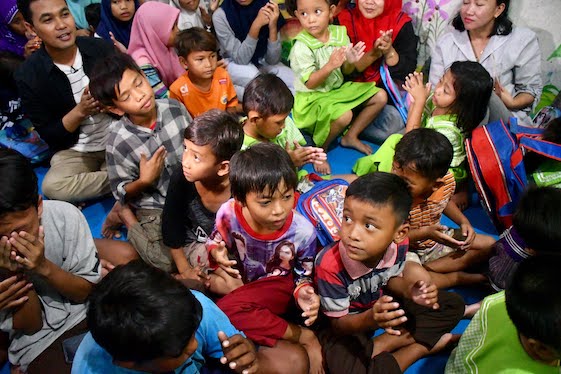
Our projects
PER’s programmes comprise two types of projects: supporting local shelters and child sponsorship, which are in line with PER’s activities since its creation. overall management structures have been introduced to ensure accountability and obligations. The projects reflect the evolving needs as addressed by the beneficiaries, and enables the monitoring of PER’s activities within the centres.
In addition to these two projects, PER maintains an emergency fund for special circumstances.
Since the late 1990s, Indonesia has been experiencing rapid economic growth, however, many households are excluded and poverty remains a challenge. According to the World Bank, out of a population of 270 million, more than 25 million Indonesians live below the poverty line (less than $1.90 USD/day), and 20% of all households remain clustered around the national poverty line set at around 240 000 Rp/month (USD 16.6). (World Bank, 2020).
Strong geographical, economic and social disparities result in a low Human Development Index, i.e. Indonesia ranks 111th out of 189, between Libya and Samoa (UNDP, 2019). Indonesian youth, representing one third of the 270 million population, is a definite asset for the development of Indonesia. However, poverty and vulnerability affects a significant number of people with the hardest hit being children and young people who are coming of age. Indicators of health, education and child protection reflect discrepancies that make it difficult for these youth to unlock their potential.
PER acknowledges the difficulties and obstacles with which a large number of Indonesian children and young people are faced with. One of PER’s main projects aims to contribute toward child welfare, and to take action for education and health requirements of disadvantaged children and youth in Indonesia
Malnutrition remains a major national concern within the poorest sections of the population, though some progress has been achieved since the 1990s (UNICEF, 2017). Stunting among children affects one-third of children under 5. Malnutrition has a significant impact on the cognitive and physical development of children, which affects their performances in school as well as their ability to learn.
The mortality rates for children under 5 has declined, but remains of concern as it is estimated that 150,000 children die each year, or approximately 350 a day. Child mortality rate is 3 times higher amongst the poorest, most vulnerable families. And as a result, a number of children die every year from what are considered treatable diseases, such as pneumonia and diarrhea. In order to prevent this, prevention and treatment services have to be made readily available to all (UNICEF, 2020).
Disability of all kinds is said to affect 3 million children and youth in Indonesia (UNICEF 2013), and families and communities are often ashamed of their disabled children. As a result, these children are often excluded and segregated from school and their community, rather than being cared for, supported or involved.
The expected average duration for school attendance in Indonesia is 12.9 years, however, actual figures indicate attendance at 8 years (7.6 for girls and 8.4 for boys) (HDI 2019). The discrepancy results from a high school dropout rate especially among children from the poorest families, most of whom are required to work.
According to UNICEF Indonesia, there are 4 million Indonesian children aged 7-18 who should be in school but are not, of which 600,000 are of primary school age, and 1.9 million are of junior/secondary school age (13-15 years). A mere 44% of the population (39.9% of women and 49.2 of men) complete secondary or higher education (HDI 2014).
Youth literacy rate is above 98.8% (HDI 2014), but this high figure masks wide geographical and gender disparities. The rate drops to around 85% in the remotest provinces and girls are generally less educated, with female literacy being around 90% (UNICEF).
According to UNICEF, some 2 million children live without their parents for a number of reasons. Some of them are placed in specialised schools and, in the worst-case scenario, they find themselves homeless and left to their own devices. According to the Ministry of Social Affairs (2018), there are approximately 160,000 street children in Indonesia, of which 2500 live in the city of Jakarta.
The right to identity is also a major impediment for marginalised children, such as street children in urban areas, disadvantaged children in villages, or children born to couples without proper marriage certificates. As of 2019, 85% of children under 5 (UNICEF 2020) are registered, but this still represents 11 million children without a birth certificate. This is a serious situation for these children, as they are denied their basic right to education and health. They cannot obtain proper identification papers (national ID card), which makes it impossible for them to either vote or work officially. They are also more exposed to child trafficking, child labour and other forms of exploitation.

